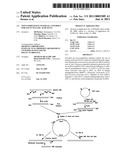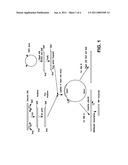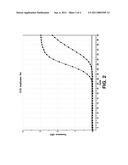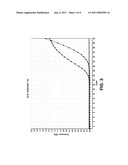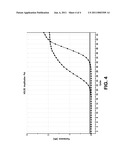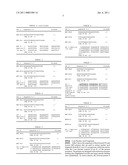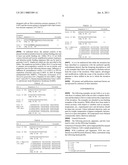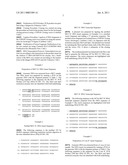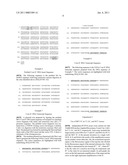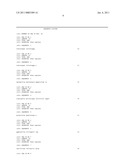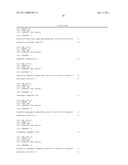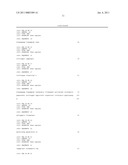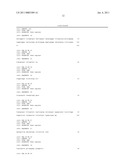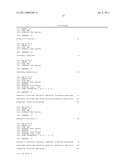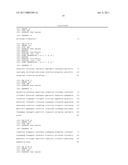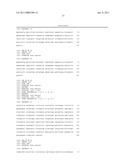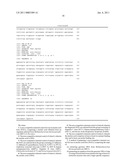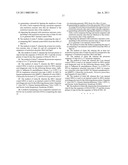Patent application title: Non-Competitive Internal Controls for Use in Nucleic Acid Tests
Inventors:
Jill Detmer (Kensington, CA, US)
Xiaoqiao Jiang (Concord, CA, US)
Minh Le (El Cerrito, CA, US)
David Sherman (Davis, CA, US)
Assignees:
SIEMENS HEALTHCARE DIAGNOSTICS INC.
IPC8 Class: AC12Q168FI
USPC Class:
435 6
Class name: Chemistry: molecular biology and microbiology measuring or testing process involving enzymes or micro-organisms; composition or test strip therefore; processes of forming such composition or test strip involving nucleic acid
Publication date: 2011-01-06
Patent application number: 20110003309
Claims:
1. A non-competitive internal control for use in nucleic acid tests
(NATs), comprising a nucleic acid obtained from an organism selected from
Methanobacterium thermoautrophicum (MET) or Zea mays.
2. The non-competitive internal control of claim 1, wherein the nucleic acid is DNA.
3. The non-competitive internal control of claim 2, wherein the NATs are selected from the group consisting of: Influenza A, Influenza B, parainfluenza viruses Ito 4 (PIV-1 to PIV-4), respiratory syncytial virus type A (RSV A), RSV B, human metapneumovirus (hMPV), Hepatitis B virus (HBV), Chlamydia trachomatis (CT), and Neisseria gonorrhea (GC).
4. The non-competitive internal control of claim 1, wherein the nucleic acid is RNA.
5. The non-competitive internal control of claim 4, wherein the diagnostic NATs are selected from the group consisting of Hepatitis C virus (HCV), Human Immunodeficiency Virus 1 (HIV-1), and Severe Acute Respiratory Syndrome (SARS).
6. The non-competitive internal control of claim 1, wherein the nucleic acid comprises at least at least two primer binding sites and at least one probe binding site.
7. A method of preparing a non-competitive internal control for use in nucleic acid tests (NATs), comprising the steps of:(a) extracting genomic DNA from Methanobacterium thermoautrophicum (MET);(b) generating an amplicon from the genomic DNA of step (a) using forward and reverse primers having at least two restriction enzyme sites and a target specific sequence;(c) generating a plasmid by ligating the amplicon of step (b) with a vector sequence having a promoter sequence and restriction enzyme sites that are identical to the restriction enzyme sites of the amplicon;(d) digesting the plasmid with restriction enzymes corresponding to the restriction enzyme sites of steps (b) and (c) to generate MET internal control DNA.
8. The method of claim 7, further comprising the step of:(e) preparing MET internal control RNA from the DNA of step (e).
9. The method of claim 7, wherein the at least two restriction enzyme sites of steps (b) and (d) correspond to the sequences of restriction enzymes XhoI and SpeI.
10. The method of claim 7, wherein the forward primer of step (b) has the sequence of SEQ ID. NO. 3 and the reverse primer of step (b) has the sequence of SEQ ID. NO. 4.
11. The method of claim 7, wherein the promoter sequence of step (c) is a T7 promoter sequence.
12. The method of claim 7, wherein the MET internal control DNA is used as an internal control in DNA nucleic acid diagnostic tests for the following disease states: Influenza A, Influenza B, parainfluenza viruses 1 to 4 (PIV-1 to PIV-4), respiratory syncytial virus type A (RSV A), RSV B, human metapneumovirus (hMPV), Hepatitis B virus (HBV), Chlamydia trachomatis (CT), and Neisseria gonorrhea (GC).
13. The method of claim 8, wherein the MET internal control RNA is used as an internal control in RNA nucleic acid diagnostic tests for the following disease states: Hepatitis C virus (HCV), Human Immunodeficiency Virus I (HIV-1), and Severe Acute Respiratory Syndrome (SARS).
14. A method of preparing a non-competitive internal control for use in nucleic acid tests (NATs) comprising the steps of:(a) extracting genomic DNA from Zea Mays (Corn);(b) generating an amplicon from the genomic DNA of step (a) using forward and reverse primers having at least two restriction enzyme sites and a target specific sequence;(c) generating a plasmid by ligating the amplicon of step (c) with a vector sequence having a promoter sequence and restriction enzyme sites that are identical to the restriction enzyme sites of the amplicon;(d) digesting the plasmid with restriction enzymes corresponding to the restriction enzyme sites of steps (b) and (c) to generate Corn internal control DNA.
15. The method of claim 14, further comprising the step of:(e) preparing Corn internal control RNA from the DNA of step (e).
16. The method of claim 14, wherein the at least two restriction enzyme sites of steps (b) and (d) correspond to the sequences of restriction enzymes XhoI and SpeI.
17. The method of claim 14, wherein the promoter sequence of step (d) is a T7 promoter sequence.
18. The method of claim 14, wherein the Corn internal control DNA is used as an internal control in DNA nucleic acid diagnostic tests for the following disease states: Influenza A, Influenza B, parainfluenza viruses 1 to 4 (PIV-1 to PIV-4), respiratory syncytial virus type A (RSV A), respiratory syncytial virus type B (RSV B), human metapneumovirus (hMPV), Chlamydia trachomatis, Neisseria gonorrhea, and Hepatitis B virus (HBV).
19. The method of claim 15, wherein the Corn internal control RNA is used as an internal control in RNA nucleic acid diagnostic tests for the following disease states: Hepatitis C virus (HCV), Human Immunodeficiency Virus I (HIV-1), and Severe Acute Respiratory Syndrome (SARS).
20. The method of claim 14, wherein the forward primer of step (b) has the sequence of SEQ ID NO. 27 and the reverse primer of step (b) has the sequence of SEQ ID NO. 28.
Description:
TECHNICAL FIELD
[0001]This application relates generally to tools for conducting diagnostic assays and more specifically to internal control sequences for use in nucleic acid tests (NATs) that do not compete with the target nucleic acid sequences.
BACKGROUND OF THE INVENTION
[0002]In order to ensure that nucleic acid tests (NATs) are properly performed, the assays require the presence of internal controls. In diagnostic NATs, the presence of an internal control can guarantee the integrity of the test. Specifically, by including an internal control in a NAT, samples testing positive for the internal control and the target nucleic acid are true positives. By contrast, samples testing only for the internal control are true negatives, samples testing only for the target nucleic acid are true negatives, and samples having no detectable internal control or target are false negatives.
[0003]The most commonly used diagnostic assay requiring the presence of internal controls is the polymerase chain reaction (PCR) assay, which is a target amplification assay in its traditional use and a target amplification and quantification assay in its modified use. There are several types of PCR assays: traditional PCR (amplification of DNA); reverse-transcriptase PCR (also known as "RT-PCR"; amplification of DNA using RNA as a starting material), real-time PCR (simultaneous quantification and amplification of DNA); and real-time RT-PCR (simultaneous quantification and amplification of DNA using RNA as a starting material).
[0004]In amplification assays, such as PCR assays, typically, one of two types of internal controls is used: competitive internal controls and non-competitive internal controls.
[0005]With competitive internal controls, the target and the internal control are amplified with one common set of primers under the same conditions and in the same PCR tube. With competitive internal controls, the internal control nucleic acid is flanked by the same primer sequence that is used to initiate amplification of the target nucleic acid. When the PCR assay is performed correctly, the IC nucleic acid will be detected during post amplification analysis. As is clear from its name, competitive internal controls are based on competition between target DNA and the internal control. For competitive internal controls to be effective, the amount of internal control in the sample tube is critical to the detection limit. A disadvantage of the use of competitive internal controls is based upon its structure, specifically, simultaneous amplification of two different nucleic acid fragments flanked by the same primer sites risks inhibition or enhancement of one or both products depending on the molar ratio, the length, the sequence, and the secondary structure of the nucleic acid fragments. Another disadvantage of competitive internal controls is that they are incapable for use in multiplex assays, which screen multiple targets in a single assay.
[0006]With non-competitive internal controls, the target and the internal control are amplified using a different primer set for each; thus, non-competitive internal controls require a PCR in which two reactions with different kinetics proceed simultaneously. Because the kinetics of the two reactions is different, there is no competition for the primers. Non-competitive internal control primer sets currently in use typically target genes other than the target gene (e.g., encoding rRNA), which are present in a sample in higher copy number than the target gene. The most commonly used non-competitive internal control in the art uses primers specific to conserved sequences of 16S and 23S ribosomal DNA. There remains a need in the art for additional non-competitive internal controls that may be prepared for use in multiple assays. An advantage of non-competitive internal controls is that unlike competitive internal controls, non-competitive internal controls they may be stored for use in multiple reactions and also may be used in multiplex reactions. There is a need in the art for such a non-competitive internal control.
SUMMARY OF THE INVENTION
[0007]The present invention overcomes the need in the art for a non-competitive internal control for use in NATs by providing nucleic acid sequences that may be prepared in the lab and stored for use in multiple reactions and in multiplex NATs.
[0008]In one aspect of the invention, there is provided a non-competitive internal control for use in nucleic acid tests (NATs) comprising a nucleic acid obtained from an organism selected from Methanobacterium thermoautrophicum (MET) and Zea mays.
[0009]In one embodiment of the invention, the non-competitive internal controls are comprised of DNA and are used in DNA NATs selected from the group consisting of Influenza A, Influenza B, parainfluenza viruses 1 to 4 (PIV-1 to PIV-4), respiratory syncytial virus type A (RSV A), RSV B, human metapneumovirus (hMPV), Chlamydia trachomatis (CT), Neisseria gonorrhea (GC [for gonococci]), and Hepatitis B virus (HBV).
[0010]In another embodiment of the invention, the non-competitive internal control are comprised of RNA and are used in RNA NATs selected from the group consisting Hepatitis C virus (HCV), Human Immunodeficiency Virus 1 (HIV-1), and Severe Acute Respiratory Syndrome (SARS).
[0011]In another aspect of the invention, there is provided, a method of preparing a non-competitive internal control for use in nucleic acid tests (NATs), comprising the steps of: (a) extracting genomic DNA from Methanobacterium thermoautrophicum (MET); (b) generating an amplicon from the genomic DNA of step (a) using forward and reverse primers having at least two restriction enzyme sites and at least one target specific sequence; (c) generating a plasmid by ligating the amplicon of step (b) with a vector sequence having a promoter sequence and restriction enzyme sites that are identical to the restriction enzyme sites of the amplicon; and (d) digesting the plasmid with restriction enzymes corresponding to the restriction enzyme sites of steps (b) and (c) to generate MET internal control DNA.
[0012]Where RNA is required, the method further comprises the step of (e): preparing MET internal control RNA from the DNA of step (d).
[0013]In a further aspect of the invention, there is provided a method of preparing a non-competitive internal control for use in nucleic acid tests (NATs), comprising the steps of: (a) extracting genomic DNA from Zea Mays (Corn); (b) generating an amplicon from the genomic DNA of step (a) using forward and reverse primers having at least two restriction enzyme sites and target specific sequence; (c) generating a plasmid by ligating the amplicon of step (b) with a vector sequence having a promoter sequence and restriction enzyme sites that are identical to the restriction enzyme sites of the amplicon; (d) digesting the plasmid with restriction enzymes corresponding to the restriction enzyme sites of steps (b) and (c) to generate Corn internal control DNA.
[0014]Where RNA is required, the method further comprises the step of: (e) preparing Corn internal control RNA from the DNA of step (d).
[0015]In one embodiment of the invention, the at least two restriction enzyme sites of steps (b) and (d) (for both MET and Corn) correspond to the sequences of restriction enzymes XhoI and SpeI.
[0016]In another embodiment of the invention, the promoter sequence of step (c) (for both MET and Corn) is a T7 promoter sequence.
[0017]In a further embodiment of the invention, the MET or Corn internal control DNA is used as an non-competitive internal control in DNA NATs selected from the group consisting of: Influenza A, Influenza B, parainfluenza viruses 1 to 4 (PIV-1 to PIV-4), respiratory syncytial virus type A (RSV A), RSV B, human metapneumovirus (hMPV), Chlamydia trachomatis (CT), Neisseria gonorrhea (GC), and Hepatitis B virus (HBV).
[0018]In yet another embodiment of the invention MET or Corn internal control RNA is used as a non-competitive internal control in RNA NATs selected from the group consisting of: Hepatitis C virus (HCV), Human Immunodeficiency Virus 1 (HIV-1), and Severe Acute Respiratory Syndrome (SARS).
[0019]Additional aspects, advantages and features of the invention will be set forth, in part, in the description that follows, and, in part, will become apparent to those skilled in the art upon examination of the following, or may be learned by practice of the invention.
BRIEF DESCRIPTION OF THE DRAWINGS
[0020]FIG. 1 is a schematic diagram of the method for preparing the internal control sequences of the present invention.
[0021]FIG. 2 is a graph of the amplification plot for Chlamydia trachomatis (CT) (left curve) and MET IC (right curve) in a single well.
[0022]FIG. 3 is a graph of the amplification plot for Neisseria gonorrhea (GC) (left curve) and MET IC (right curve) in a single well.
[0023]FIG. 4 is a graph of the amplification plot for Hepatitis C virus (HCV) (left curve) and MET IC (right curve) in a single well.
DETAILED DESCRIPTION OF THE INVENTION
[0024]Set forth below is a description of what are currently believed to be the preferred embodiments and best examples of the claimed invention. Any alternates or modifications in function, purpose, or structure are intended to be covered by the claims of this application.
DEFINITIONS
[0025]In describing and claiming the present invention, the following terminology the following definitions are used for the purpose of describing particular embodiments only, and is not intended to be limiting. As used in this specification and the appended claims, the singular forms "a," "an," and "the" include plural referents unless the context clearly dictates otherwise.
[0026]The term "non-competitive internal control" refers to an internal control nucleic acid sequence that includes primer sites that are not present in the target nucleic acid sequence.
[0027]The term "competitive internal control" refers to an internal control nucleic acid sequence that includes primer sites that are also present in the target nucleic acid sequence.
[0028]The terms "FW" and "FP" indicate forward primers and the terms "RV" and "RP" indicate reverse primers. The term "P" when used alone refers to a probe.
[0029]The term "PCR primer for the construction of internal control (IC) clone" refers to oligonucleotides that were designed to introduce unique sequences and restriction sites into a newly constructed IC plasmid DNA through overlapping PCR reactions.
[0030]The term "amplification primer" (also referred to herein as "primer") refers to an oligonucleotide that is complementary to DNA or RNA molecules and provides the 3-OH-end of a substrate to which any DNA polymerase can add the nucleotides of a growing DNA chain in the 5 to 3 direction.
[0031]The term "detection probe" (also referred to herein as "probe") refers to an oligonucleotide capable of selectively hybridizing to the amplified target nucleic acid under appropriate conditions. The detection probe may consist of a nucleotide with 5-reporter dye (R) and a 3-quencher dye (Q). A fluorescent reporter dye and fluorophore or a quencher that is either red-shifted fluorescent or non-fluorescent may be covalently linked to the 5-end or 3-end of the oligonucleotide. The detection probe acts as a TAQMAN® (Applied Biosystems, Foster City, Calif.) probe or other detection probes, such as beacons, non-nuclease real time amplification probes during amplification and detection process.
[0032]The term "diagnostic target (unknown)" refers to the nucleic acid sequence(s) that the PCR assay has been designed to detect specifically. Examples of these assays include targets, such as for example, Hepatitis B Virus (HBV), Hepatitis C Virus (HCV), and Human Immunodeficiency Virus (HIV).
[0033]The term "diagnostic target (known)" refers to the unique DNA or RNA target that is spiked at a known concentration into either the extraction step or amplification mixture used to isolate and amplify the Specific Diagnostic Target whose presence or quantity in the sample is unknown. In addition, unique primers and probes that recognize the unique fragments of RNA or DNA are added into the amplification mixture. These internal controls can be used to monitor the efficiency of the target extraction, amplification, and detection in real time kPCR assays.
[0034]As used herein, the term "target amplification" refers to enzyme-mediated procedures that are capable of producing billions of copies of nucleic acid target. Examples of enzyme-mediated target amplification procedures known in the art include PCR, nucleic acid-sequence-based amplification ("NASBA"), transcription-mediated amplification ("TMA"), strand displacement amplification ("SDA"), and ligase chain reaction ("LCR"). The most widely used target amplification procedure is PCR, first described for the amplification of DNA by Mullins et al. in U.S. Pat. No. 4,683,195 and Mullis in U.S. Pat. No. 4,683,202. The PCR procedure is well known to those of ordinary skill in the art. Where the starting material for the PCR reaction is RNA, complementary DNA ("cDNA") is made from RNA via reverse transcription. A PCR used to amplify RNA products is referred to as reverse transcriptase PCR or "RT-PCR."
[0035]In the PCR technique, a sample of DNA is mixed in a solution with a molar excess of two oligonucleotide primers of 10-30 base pairs each that are prepared to be complementary to the 3' end of each strand of the DNA duplex; a molar excess of unattached nucleotide bases (i.e., dNTPs); and DNA polymerase, (preferably Taq polymerase, which is stable to heat), which catalyzes the formation of DNA from the oligonucleotide primers and dNTPs. Of the two primers, one is a forward primer that will bind in the 5'-3' direction to the 3' end of one strand of the denatured DNA analyte and the other is a reverse primer that will bind in the 3'-5' direction to the 5' end of the other strand of the denatured DNA analyte. The solution is heated to 94-96° C. to denature the double-stranded DNA to single-stranded DNA. When the solution cools, the primers bind to the separated strands and the DNA polymerase catalyzes a new strand of analyte by joining the dNTPs to the primers. When the process is repeated and the extension products synthesized from the primers are separated from their complements, each extension product serves as a template for a complementary extension product synthesized from the other primer. In other words, an extension product synthesized from the forward primer, upon separation, would serve as a template for a complementary extension product synthesized from the reverse primer. Similarly, the extension product synthesized from the reverse primer, upon separation, would serve as a template for a complementary extension product synthesized from the forward primer. In this way, the region of DNA between the primers is selectively replicated with each repetition of the process. Since the sequence being amplified doubles after each cycle, a theoretical amplification of one billion copies may be attained after repeating the process for a few hours; accordingly, extremely small quantities of DNA may be amplified using PCR in a relatively short period of time.
[0036]As used herein, the term "amplicon" refers to amplified nucleic acid product, such as for example, amplified PCR product.
[0037]Where the starting material for the PCR reaction is RNA, complementary DNA ("cDNA") is made from RNA via reverse transcription. The resultant cDNA is then amplified using the PCR protocol described above. Reverse transcriptases are known to those of ordinary skill in the art as enzymes found in retroviruses that can synthesize complementary single strands of DNA from an mRNA sequence as a template. The enzymes are used in genetic engineering to produce specific cDNA molecules from purified preparations of mRNA. A PCR used to amplify RNA products is referred to as reverse transcriptase PCR or "RT-PCR."
[0038]The terms "real-time PCR" and "real-time RT-PCR," also known in the art as "kinetic PCR" ("kPCR") or "kinetic RT-PCR" ("kRT-PCR"), refers to modified PCR assays that are used for simultaneous amplification and quantification of DNA. With real-time PCR, PCR products are detected via a fluorescent signal generated by the coupling of a fluorogenic dye molecule and a quencher moiety to the same or different oligonucleotide substrates. Examples of commonly used probes used in kPCR and kRT-PCR include the following probes: TAQMAN® probes (Applied Biosystems, Foster City, Calif.), Molecular Beacons probes (PHRI, Neward, N.J.), SCORPION® probes (DXS Ltd, Manchester, UK), and SYBR® Green probes (Invitrogen, Carlsbad, Calif.). Briefly, TAQMAN® probes, Molecular Beacons, and SCORPION® probes each have a fluorescent reporter dye (also called a "fluor") attached to the 5' end of the probes and a quencher moiety coupled to the 3' end of the probes. In the unhybridized state, the proximity of the fluor and the quench molecules prevents the detection of fluorescent signal from the probe. By contrast, during PCR, when the polymerase replicates a template on which a probe is bound, the 5'-nuclease activity of the polymerase cleaves the probe thus increasing fluorescence with each replication cycle. SYBR® Green probes binds double-stranded DNA and upon excitation emit light; thus as PCR product accumulates, fluorescence increases.
[0039]The terms "complementary" and "substantially complementary" refer to base pairing between nucleotides or nucleic acids, such as, for instance, between the two strands of a double-stranded DNA molecule or between an oligonucleotide primer and a primer binding site on a single-stranded nucleic acid to be sequenced or amplified. Complementary nucleotides are, generally, A and T (or A and U), and G and C. Within the context of the present invention, it is to be understood that the specific sequence lengths listed are illustrative and not limiting and that sequences covering the same map positions, but having slightly fewer or greater numbers of bases are deemed to be equivalents of the sequences and fall within the scope of the invention, provided they will hybridize to the same positions on the target as the listed sequences. Because it is understood that nucleic acids do not require complete complementarity in order to hybridize, the probe and primer sequences disclosed herein may be modified to some extent without loss of utility as specific primers and probes. Generally, sequences having homology of 80% or more fall within the scope of the present invention.
[0040]As used herein, the term "cloning" is used to refer to "molecular cloning," which is a process that creates multiple copies of a nucleic acid sequence (also referred to herein as an "insert"), such as unique genes or selectable genetic markers, from a single copy of the insert. The cloning process typically occurs in a "cloning vector" (also referred to herein as "vector"), which is a DNA molecule, such as a plasmid or viral DNA chromosome, that is capable of replication in a suitable host cell. A "plasmid" is known in the art as a circular double-stranded DNA molecule that is obtained from a bacterial species. A cloning vector typically has one or more suitable sites for the insertion of the nucleic acid sequences. In a successful cloning, the cloning vector is introduced into the host cell and replication of the cloning vector in the host cell results in a transformed host cell, which expresses the nucleic acid sequences that were inserted into the cloning vector. Replication of the cloning vector in the host cell is typically initiated in via a "promoter," which is a regulatory region of DNA located upstream (towards the 5' region) of a gene, and which binds RNA polymerase and transcription factors to initiate RNA transcription. Using this procedure and as shown in FIG. 1, the cloning vector can be used as a template to produce an RNA internal control by routine transcription reaction or a DNA internal control by restriction digestion.
[0041]As explained in the Background section, when a non-competitive internal control is used in an amplification reaction, such as PCR, different primer sets are used for the internal control and for the target. The use of the non-competitive internal controls thus requires a PCR in which two reactions with different kinetics proceed simultaneously and the kinetics of each reaction are not influenced by competition for the primers.
[0042]An advantage of non-competitive internal controls over competitive internal controls is that because non-competitive internal controls are prepared with their own set of primers, they may be used for many different assays in the same laboratory. Another advantage of non-competitive internal controls is that they can be used for multiplex PCR assays. By contrast, competitive internal controls cannot be used with multiplex PCR assays in which several primer pairs are required. As is known to those of skill in the art, multiplex PCR has much usefulness for molecular diagnostics since multiple pathogens producing similar symptoms may be screened simultaneously in a single reaction.
[0043]The non-competitive internal controls of the present invention have at least two primer binding sites and at least one probe binding site. As non-competitive controls, the internal controls of the present invention have unique cloning sequences that do not compete with the target nucleic acid sequences. The internal controls are independently designed from the genomes of the organisms Methanobacterium thermoautrophicum (MET) Zea Mays (Corn). Nucleic acids isolated from the organisms are constructed into a plasmid with a cloning vector.
[0044]Procedures for cloning nucleic acids are known to those of skill in the art. FIG. 1 shows an exemplary procedure to clone the internal control nucleic acids of the present invention; the procedure set forth in FIG. 1 was used to generate the non-competitive internal controls described in the Examples. As shown in FIG. 1, the isolated genomic DNA is digested with XhoI and SpeI restriction enzymes and the resulting DNA insert is amplified using PCR and purified. Separately, a vector fragment is prepared from the TOPO® Cloning Vector (Invitrogen, Carlsbad, Calif.), which is digested with XhoI and SpeI restriction enzymes to form a vector fragment with XhoI and SpeI sticky ends, which is subsequently purified. The DNA insert and the vector fragment are then ligated by matching the XhoI and SpeI sticky ends to form a plasmid that includes the genomic DNA insert, the vector fragment, and a T7 promoter sequence. The T7 promoter sequence will typically be either a 20-mer T7 promoter sequence 5'-TAA TAC GAG TCA CTA TAG GG-3' (SEQ ID NO. 1) or a 21-mer T7 promoter sequence 5'-TAA TAC GAG TCA CTA TAG GGA-3' (SEQ ID NO. 2). The internal control DNA sequences of the present invention are generated by digesting the plasmid with XhoI or SpeI. The internal control RNA sequences are obtained by transcribing the DNA under conditions known to those of skill in the art.
[0045]Modifications to the procedures set forth in FIG. 1, such as for example, replacing the T7 promoter with other promoters known in the art, such as the T3 and SP6 promoters, or flanking the MET or Corn inserts with more than one promoter are within the skill level of those in the art. Similarly, it would be within the skill level of one in the art to modify the method set forth herein by replacing the XhoI and SpeI restriction binding sites with binding sites for other suitable restriction enzymes.
[0046]The DNA internal controls of the present invention have utility in DNA nucleic acid tests (DATs), including without limitation: Influenza A, Influenza B, parainfluenza viruses 1 to 4 (PIV-1 to PIV-4), respiratory syncytial virus type A (RSV A), RSV B, human metapneumovirus (hMPV), Chlamydia trachomatis (CT), Neisseria gonorrhea (GC), and Hepatitis B virus (HBV).
[0047]The RNA internal controls of the present invention have utility in RNA nucleic acid tests (NATs), including without limitation: Hepatitis C virus (HCV), Human Immunodeficiency Virus 1 (HIV-1), and Severe Acute Respiratory Syndrome (SARS).
[0048]In practice, it is to be understood that the internal controls of the present invention are included in the same reaction mix as the sample that is being targeted. In one embodiment of the invention, the internal controls are introduced at the step of virus lysis and consequently, can be used to monitor the RNA or DNA target capture or release at the sample preparation step and/or to monitor the target amplification and detection during real time PCR.
[0049]Internal Control Fragments and Primer and Probe Sets:
[0050]A sequence listing describes the (i) DNA insert during cloning; (ii) resulting complete double-stranded DNA sequence based on purification following restriction enzyme digest; and (iii) sequence of the single-stranded RNA generated from the T7 promoter with attached vector sequences.
[0051]Met Nucleic Acid Fragments
[0052]Table 1 shows the sequences of the forward (FP) and reverse (RP) primers that are used to extract nucleic acid fragments from the M. thermoautrophicum (MET) genome, which are used to clone the MET internal controls (MET IC) of the present invention. The primers are designed with restriction enzymes binding sites (highlighted in bold) and target specific binding sites (underlined). As shown therein, the forward primer is designed with an XhoI restriction enzyme sequence (C/TCGAG) and the reverse primer is designed with a SpeI restriction enzyme sequence (A/CTAGT).
TABLE-US-00001 TABLE 1 Frag- ment Prim- ers Sequence 5-3 Strands MET IC AGTAGTCTCGAGCATGTGCAGGGATCCTGACA (+) FP (SEQ ID. NO. 3) MET IC TCGTCGACTAGTTCACCGAGCACCTCCTTCAGGCT (-) RP (SEQ ID NO. 4)
[0053]As indicated above, the internal controls of the present invention include at least two primer binding sites and at least one probe binding site. Tables 2 to 8 set forth various forward and reverse amplification primer sequences and detection probe binding sequences that can be used to generate MET IC Amplicons, which are also provided in the tables. The amplicons set forth in Tables 2 to 8 can be used to prepare non-competitive controls for use in nucleic acid diagnostic tests for the following disease states: Influenza A, Influenza B, parainfluenza viruses 1 to 4 (PIV-1 to PIV-4), respiratory syncytial virus type A (RSV A), RSV B, human metapneumovirus (hMPV), Chlamydia trachomatis (CT), Neisseria gonorrhea (GC), Hepatitis B virus (HBV), Hepatitis C virus (HCV), Human Immunodeficiency Virus 1 (HIV-1), and Severe Acute Respiratory Syndrome (SARS).
TABLE-US-00002 TABLE 2 Set 1 Sequence 5-3 Strands MET-FW01 GCCGCCATAAGAGCCATAGAA (+) (SEQ ID NO. 5) MET-RV01 GGGTAATTTGTCTCTGGCTTTGA (-) (SEQ ID NO. 6) MET-P01 CGCCCTTTGATATCTGCTCCGCAG (+) (SEQ ID NO. 7) MET IC 1 GCCGCCATAA GAGCCATAGA GGAGGTTGAG Amplicon 31 GGTGTTGTGA CGCCCTTTGA TATCTGCTCC (96 pbs) 61 GCAGCATCAA AGCCAGAGAC AAATTACCC (SEQ ID No. 8)
TABLE-US-00003 TABLE 3 Set 2 Sequence 5-3 Strands MET-FW02 AGAGGAGGTTGAGGGTGTTGTG (+) (SEQ ID NO. 9) MET-RV01 GGGTAATTTGTCTCTGGCTTTGA (-) (SEQ ID NO. 6) MET-P02 CGCCCTTTGATATCTGCTCCGCAG (+) (SEQ ID NO. 7) Set 2 1 AGAGCCATAG AGGAGGTTGA GGGTGTTGTG Amplicon 31 ACGCCCTTTG ATATCTGCTC CGCAGCATCA (80 bps) 61 AAGCCAGAGA CAAATTACCC C (SEQ ID NO. 10)
TABLE-US-00004 TABLE 4 Set 3 Sequence 5-3 Strands MET-FW03 TAGAGGAGGTTGAGGGTGTTGTG (+) (SEQ ID NO. 11) MET-RV01 GGGTAATTTGTCTCTGGCTTTGA (-) (SEQ ID NO. 6) MET-P02 CGCCCTTTCATATCTGCTCCGCAG (+) (SEQ ID NO. 7) Set 3 1 TAGAGCCATA GAGGAGGTTG AGGGTGTTGT Amplicon 31 GACGCCCTTT GATATCTGCT CCGCAGCATC (81 bps) 61 AAAGCCAGAG ACAAATTACC C (SEQ ID NO. 12)
TABLE-US-00005 TABLE 5 Set 4 Sequence 5-3 Strands MET-FW04 ATAGAGGAGGTTGAGGGTGTTGTG (+) (SEQ ID NO. 13) MET-RV01 GGGTAATTTGTCTCTGGCTTTGA (-) (SEQ ID NO. 6) MET P02 CGCCCTTTCATATCTGCTCCGCAG (+) (SEQ ID NO. 7) Set 4 Amplicon 1 ATAGAGCCAT AGAGGAGGTT GAGGGTGTTG (82 bps) 31 TGACGCCCTT TGATATCTGC TCCGCAGCAT 61 CAAAGCCAGA GACAAATTAC CC (SEQ ID NO. 14)
TABLE-US-00006 TABLE 6 Set 5 Sequence 5-3 Strands MET-FW05 ATAGAGGAGGTTGAGGGTGTTGTG (+) (SEQ ID NO. 15) MET-RV05 CCTTCAGGCTCGGGCAGTA (-) (SEQ ID NO. 16) MET-P05 CCCTTTGAGATCTGCTCCGCA (+) (SEQ ID NO. 17) Set 5 Amplicon 1 ATAGAGGAGG TTGAGGGTGT TGTGACGCCC (121 bps) 31 TTTGAGAGCT GCTCCGCAGC ATCAAAGCCA 61 GAGACAAATT ACCCCTGGAT AGGCCCCACC 91 ACGAACCACC CCTACTGCCC GAGCCTGAAG 121 G (SEQ ID NO. 18)
TABLE-US-00007 TABLE 7 Set 6 Sequence 5-3 Strands MET-FW06 AATTGGGCCCTCTAGATGCA (+) (SEQ ID NO. 19) MET-RV06 GATATCAAAGGGCGTCACAACA (-) (SEQ ID NO. 20) MET-P06 CAGGGCCGCCATAAGAGCCATAG (+) (SEQ ID NO. 21) Set 6 1 AATTGGGCCC TCTAGATGCA TGCTCGAGCA Amplicon 31 TGTGCAGGGA TCCTGACACG GTACTGGAGG (122 bps) 61 CAGGCAGGGC CGCCATAAGA GCCATAGAGG (Vector 91 AGGTTGAGGG TGTTGTGACG CCCTTTGAGA sequence is 121 TC highlighted (SEQ ID NO. 22) in bold underlining)
TABLE-US-00008 TABLE 8 Set 7 Sequence 5-3 Strands MET-FW07 TTGTGACGCCCTTTGATATCTG (+) (SEQ ID NO. 23) MET-RV05 CCTTCAGGCTCGGGCAGTA (-) (SEQ ID NO. 16) METP07a CTGGATAGGCCCCACCACGAACC (+) (SEQ ID NO. 24) METP07b TCCGCAGCATCAAAGCCAGAGACA (SEQ ID NO. 25) Set 7 Amplicon 1 TTGTGACGCC CTTTGATATC TGCTCCGCAG (102 bps) 31 CATCAAAGCC AGAGACAAAT TACCCCTGGA 61 TAGGCCCCAC CACGAACCAC CCCTACTGCC 91 CGAGCCTGAA GG (SEQ ID NO. 26)
[0054]Corn Nucleic Acid Fragments
[0055]Table 9 shows the sequences of the forward (FP) and reverse (RP) primers that are used to extract nucleic acid fragments from the Z. mays (Corn) genome, which are used to clone the Corn internal controls (Corn IC) of the present invention. The primers are designed with restriction enzymes binding sites (highlighted in bold) and target specific binding sites (underlined). As shown therein, the forward primer is designed with an XhoI restriction enzyme sequence (C/TCGAG) and the reverse primer is designed with a SpeI restriction enzyme sequence (A/CTAGT).
TABLE-US-00009 TABLE 9 Fragment Primers Sequence 5-3 Strands Corn 1 AGTAGTCTCGAGTAAATAGCCCTCACCCACCAAC (+) IC FP (SEQ ID. NO. 27) Corn 1 TCGTCGACTAGTCCGAGAGCGCAGGCTTC (-) IC RP (SEQ ID NO. 28)
[0056]As indicated above, the internal controls of the present invention include at least two primer binding sites and at least one probe binding site. Tables 10 to 12 set forth various forward and reverse amplification primer sequences and detection probe binding sequences that can be used to generate Corn IC Amplicons which are also provided in the tables. The amplicons set forth in Tables 10 to 12 can be used to prepare non-competitive controls for use in nucleic acid diagnostic tests for the following disease states: Influenza A, Influenza B, parainfluenza viruses 1 to 4 (PIV-1 to PIV-4), respiratory syncytial virus type A (RSV A), RSV B, human metapneumovirus (hMPV), Chlamydia trachomatis (CT), Neisseria gonorrhea (GC), Hepatitis B virus (HBV), Hepatitis C virus (HCV), Human Immunodeficiency Virus 1 (HIV-1), and Severe Acute Respiratory Syndrome (SARS).
TABLE-US-00010 TABLE 10 Set 1 Sequence 5-3 Strands Corn1 IC FP1 AATAGCCCTCACCCACCAACT (+) (SEQ ID NO. 29) Corn1 IC RP1 TCCAACGGCTCTGTGTCAGA (-) (SEQ ID NO. 30) Corn1 IC CCGTTACAGGCAAGTTACTGCG (+) Probe 1 (SEQ ID NO. 31) Corn IC 1 AATAGCCCTC ACCCACCAAC TAGCCGTTAC Amplicon 31 AGGCAAGTTA CTGCGCGATG GCGCACCGGA (150 pbs) 61 CAGTCCGGTG CGCCACCGGT GCGCCACCGG 91 TGCGCCACCG GTGCGCCAAC GGTCACTTNC 121 AACGGCTAGT TCTGACACAG AGCCGTTGGA (SEQ ID NO. 32)
TABLE-US-00011 TABLE 11 Set 2 Sequence 5-3 Strands Corn1 IC FP2 AAATAGCCCTCACCCACCAACT (+) (SEQ ID NO. 33) Corn1 IC RP1 TCCAACGGCTCTGTGTCAGA (-) (SEQ ID NO. 30) Corn1 IC CCGTTACAGGCAAGTTACTGCG (+) Probe 1 (SEQ ID NO. 31) Set 2 Amplicon 1 AAATAGCCCT CACCCACCAA CTAGCCGTTA (151 pbs) 31 CAGGCAAGTT ACTGCGCGAT GGCGCACCGG 61 ACAGTCCGGT GCGCCACCGG TGCGCCACCG 91 GTGCGCCACC GGTGCGCCAA CGGTCACTTN 121 CAACGGCTAG TTCTGACACA GAGCCGTTGG 151 A (SEQ ID NO. 34)
TABLE-US-00012 TABLE 12 Set 3 Sequence 5-3 Strands Corn1 IC FP1 AATAGCCCTCACCCACCAACT (+) (SEQ ID NO. 29) Corn1 IC RP3 GTCCAACGGCTCTGTGTCAGA (-) (SEQ ID NO. 35) Corn1 IC CCGTTACAGGCAAGTTACTGCG (+) Probe 1 (SEQ ID NO. 31) Set 3 Amplicon 1 AATAGCCCTC ACCCACCAAC TAGCCGTTAC (151 pbs) 31 AGGCAAGTTA CTGCGCGATG GGTCACTTNC 61 CAGTCCGGTG CGCCACCGGT GCGCCACCGG 91 TGCGCCACCG GTGCGCCAAC GGTCACTTNC 121 AACGGCTAGT TCTGACACAG AGCCGTTGGA 151 C (SEQ ID NO. 36)
[0057]It is to be understood that while the invention has been described in conjunction with the preferred specific embodiments thereof, that the foregoing description as well as the examples that follow are intended to illustrate and not limit the scope of the invention. Other aspects, advantages and modifications within the scope of the invention will be apparent to those skilled in the art to which the invention pertains.
[0058]All patents and publications mentioned herein are incorporated by reference in their entireties.
EXPERIMENTAL
[0059]The following examples are put forth so as to provide those of ordinary skill in the art with a complete disclosure and description of how to make and use the compositions of the invention. The examples are intended as non-limiting examples of the invention. While efforts have been made to ensure accuracy with respect to variables such as amounts, temperature, etc., experimental error and deviations should be taken into account. Unless indicated otherwise, parts are parts by weight, temperature is degrees centigrade, and pressure is at or near atmospheric. All components were obtained commercially unless otherwise indicated.
[0060]General Protocols:
[0061]The following protocols, apparatus, and kits were used to carry out the following Examples.
Extraction of Genomic DNA: native target purified by manual Qiagen (Valencia, Calif.) sample preparation kit.
[0062]PCR Conditions and Apparatus: PCR was conducted on an MJ Research (Ramsey, Minn.) instrument using the following thermoprofile:
TABLE-US-00013 95° 10 min - 1 step 95° 15 sec 60° 15 sec {close oversize brace} repeated for 30 cycles 68° 1 min 72° 10 min 4° overnight (until removed)
[0063]Purification of PCR Product: PCR product was purified using a Qiagen kit (Valencia, Calif.)
[0064]Cloning Procedure: Cloning was carried out using the procedure set forth in the product insert for the Invitrogen cloning protocol using a TOPO® Cloning vector (Carlsbad, Calif.).
[0065]Ligation Procedure: Ligation of DNA fragments to the TOPO® Cloning vector was carried out using the instructions for Invitrogen T4 ligase (Carlsbad, Calif.).
[0066]Purification of Vector Fragment: Purification of vector was carried out using Clontech NUCLEOSPIN® RNA Purification Kit (Mountain View, Calif.).
[0067]RNA Transcription Protocol: Transcription was carried out according to the instructions in the product insert for the Ambion T7 MEGASCRIPT® kit (Austin, Tex.). Purification of the RNA was carried out according to the instructions in the Qiagen RNEASY® mini kit (Valencia, Calif.).
Example 1
Preparation of MET IC DNA Insert Sequence
[0068]Genomic DNA was extracted from a MET sample. The DNA insert was prepared by running a PCR on the genomic DNA with the fragment primers of Table 1. The following sequence is the sequence for the MET IC PCR Product (213 bp) (SEQ ID NO. 37). The XhoI and SpeI restriction enzyme sites are identified with bold underlining.
TABLE-US-00014 1 AGTAGTCTCG AGCATGTGCA GGGATCCTGA CACGGTACTG TCATCAGAGC TCGTACACGT CCCTAGGACT GTGCCATGAC 41 GAGGCAGGCA GGGCCGCCAT AAGAGCCATA GAGGAGGTTG CTCCGTCCGT CCCGGCGGTA TTCTCGGTAT CTCCTCCAAC 81 AGGGTGTTGT GACGCCCTTT GATATCTGCT CCGCAGCATC TCCCACAACA CTGCGGGAAA CTATAGACGA GGCGTCGTAG 121 AAAGCCAGAG ACAAATTACC CCTGGATAGG CCCCACCACG TTTCGGTCTC TGTTTAATGG GGACCTATCC GGGGTGGTGC 161 AACCACCCCT ACTGCCCGAG CCTGAAGGAG GTGCTCGGTG TTGGTGGGGA TGACGGGCTC GGACTTCCTC CACGAGCCAC 201 AACTAGTCGA CGA TTGATCAGCT GCT
Example 2
Purified MET IC DNA Insert Sequence
[0069]The following sequence is the purified 195 by dsDNA sequence following restriction enzyme digestion at the sites identified above (SEQ ID NO. 38):
TABLE-US-00015 1 TCGAGCATGT GCAGGGATCC TGACACGGTA CTGGAGGCAG 41 GCAGGGCCGC CATAAGAGCC ATAGAGGAGG TTGAGGGTGT 81 TGTGACGCCC TTTGATATCT GCTCCGCAGC ATCAAAGCCA 121 GAGACAAATT ACCCCTGGAT AGGCCCCACC ACGAACCACC 161 CCTACTGCCC GAGCCTGAAG GAGGTGCTCG GTGAA
Example 3
MET IC DNA Transcript Sequence
[0070]A plasmid was prepared by ligating the purified MET IC DNA insert sequence of Example 2 to a purified vector fragment and adding a T7 promoter sequence. The purified vector fragment was isolated from a TOPO® Cloning vector (Invitrogen, Carlsbad, Calif.) via digestion with the restriction enzymes XhoI and SpeI. The plasmid was formed by matching the XhoI and SpeI sticky ends of the DNA insert and the vector. FIG. 1 shows a schematic of the cloning process.
[0071]The resultant plasmid was linearized with Xho1 and SpeI to generate the following 247 by MET IC DNA transcript sequence. The vector sequences are highlighted with bold underlining (SEQ ID NO. 39):
TABLE-US-00016 1 GGGCGAATTG GGCCCTCTAG ATGCATGCTC GAGCATGTGC 41 AGGGATCCTG ACACGGTACT GGAGGCAGGC AGGGCCGCCA 81 TAAGAGCCAT AGAGGAGGTT GAGGGTGTTG TGACGCCCTT 121 TGATATCTGC TCCGCAGCAT CAAAGCCAGA GACAAATTAC 161 CCCTGGATAG GCCCCACCAC GAACCACCCC TACTGCCCGA 201 GCCTGAAGGA GGTGCTCGGT GAACTAGTGG ATCCGAGCTC 241 GGTACCA
Example 4
MET IC RNA Transcript Sequence
[0072]The following sequence is the 247 by MET IC RNA transcript sequence prepared from the DNA sequence of Example 3. The vector sequences are highlighted with bold underlining (SEQ ID NO. 40):
TABLE-US-00017 1 GGGCGAAUUG GGCCCUCUAG AUGCAUGCUC GAGCAUGUGC 41 AGGGAUCCUG ACACGGUACU GGAGGCAGGC AGGGCCGCCA 81 UAAGAGCCAU AGAGGAGGUU GAGGGUGUUG UGACGCCCUU 121 UGAUAUCUGC UCCGCAGCAU CAAAGCCAGA GACAAAUUAC 161 CCCUGGAUAG GCCCCACCAC GAACCACCCC UACUGCCCGA 201 GCCUGAAGGA GGUGCUCGGU GAACUAGUGG AUCCGAGCUC 241 GGUACCA
Example 5
Preparation of Corn IC Insert Sequence
[0073]Genomic DNA was extracted from a Z. mays (Corn) sample. The DNA insert was prepared by running a PCR on the genomic DNA with the fragment primers of Table 9. The following sequence is the sequence for the Corn IC PCR Product (284 bp) (SEQ ID NO. 41). The XhoI and SpeI restriction enzyme sites are identified with bold underlining.
TABLE-US-00018 1 AGTAGTCTCG AGTAAATAGC CCTCACCCAC CAACTAGCCG TCATCAGAGC TCATTTATCG GGAGTGGGTG GTTGATCGGC 41 TTACAGGCAA GTTACTGCGC GATGGCGCAC CGGACAGTCC AATGTCCGTT CAATGACGCG CTACCGCGTG GCCTGTCAGG 81 GGTGCGCCAC CGGTGCGCCA CCGGTGCGCC ACCGGTGCGC CCACGCGGTC GCCACGCGGT GGCCACGCGG TGGCCACGCG 121 CAACGGTCAC TTNCAACGGC TAGTTCTGAC ACAGAGCCGT GTTGCCAGTG AANGTTGCCG ATCAAGACTG TGTCTCGGCA 161 TGGACTCATG ACGCACCGGA CAGTGAATAG TTCACTGTCC ACCTGAGTAC TGCGTGGCCT GTCACTTATC AAGTGACAGG 201 GGTGCACACC GGACAGTCCG GTGCGGTGTC CGGTGTGCCA CCACGTGTGG CCTGTCAGGC CACGCCACAG GCCACACGGT 241 CTAAAATTCA TCTCCGAAGC CTGCGCTCTC GGACTAGTCG GATTTTAAGT AGAGGCTTCG GACGCGAGAG CCTGATCAGC 281 ACGA TGCT
Example 6
Purified Corn IC DNA Insert Sequence
[0074]The following sequence is the purified 266 by dsDNA sequence following restriction enzyme digestion at the sites identified above (SEQ ID NO. 42):
TABLE-US-00019 1 TCGAGTAAAT AGCCCTCACC CACCAACTAG CCGTTACAGG 41 CAAGTTACTG CGVGATGGCG CACCGGACAG TCCGGTGCGC 81 CACCGGTGCG CCACCGGTGC GCCACCGGTG CGCCAACGGT 121 CACTTCCAAC GGCTAGTTCT GACACAGAGC CGTTGGACTC 161 ATGACGCACC GGACAGTGAA TAGTTCACTG TCCGGTGCAC 201 ACCGGACAGT CCGGTGCGGT GTCCGGTGTG CCACTAAAAT 241 TCATCTCCGA AGCCTGCGCT CTCGGA
Example 7
Corn IC DNA Transcript Sequence
[0075]A plasmid was prepared by ligating the purified MET Corn IC DNA insert sequence of Example 6 to a purified vector fragment with sticky end restriction sites and a T7 promoter sequence. The purified vector fragment was isolated from a TOPO® Cloning vector (Invitrogen, Carlsbad, Calif.) via digestion with the restriction enzymes XhoI and SpeI. The plasmid was formed by matching the XhoI and SpeI sticky ends of the DNA insert and the vector. FIG. 1 shows a schematic of the cloning process.
[0076]The resultant plasmid was linearized with Xho1 and SpeI to generate the following 318 by Corn IC DNA transcript sequence. The vector sequences are highlighted with bold underlining (SEQ ID NO. 43):
TABLE-US-00020 1 GGGCGAATTG GGCCCTCTAG ATGCATGCTC GAGTAAATAG 41 CCCTCACCCA CCAACTAGCC GTTACAGGCA AGTTACTGCG 81 CGATGGCGCA CCGGACAGTC CGGTGCGCCA CCGGTGCGCC 121 ACCGGTGCGC CACCGGTGCG CCAACGGTCA CTTNCAACGG 161 CTAGTTCTGA CACAGAGCCG TTGGACTCAT GACGCACCGG 201 ACAGTGAATA GTTCACTGTC CGGTGCACAC CGGACAGTCC 241 GGTGCGGTGT CCGGTGTGCC ACTAAAATTC ATCTCCGAAG 281 CCTGCGCTCT CGGACTAGTG CATCCGAGCT CGGTACCA
Example 8
Corn IC RNA Transcript Sequence
[0077]The following sequence is the 318 by Corn IC RNA transcript sequence prepared from the DNA sequence of Example 7. The vector sequences are highlighted with bold underlining (SEQ ID NO. 44):
TABLE-US-00021 1 GGGCGAAUUG GGCCCUCUAG AUGCAUGCUC GAGUAAAUAG 41 CCCUCACCCA CCAACUAGCC GUUACAGGCA AGUUACUGCG 81 CGAUGGCGCA CCGGACAGUC CGGUGCGCCA CCGGUGCGCC 121 ACCGGUGCGC CACCGGUGCG CCAACGGUCA CUUNCAACGG 161 CUAGUUCUGA CACAGAGCCG UUGGACUCAU GACGCACCGG 201 ACAGUGAAUA GUUCACUGUC CGGUGCACAC CGGACAGUCC 241 GGUGCGGUGU CCGGUGUGCC ACUAAAAUUC AUCUCCGAAG 281 CCUGCGCUCU CGGACUAGUG CAUCCGAGCU CGGUACCA
Experiment 9
Use of MET IC in CT, GC, and HCV Assays
[0078]Independent RT-PCR assays were carried out with TAQMAN® probes (Applied Biosystems, Foster City, Calif.) for CT, GC, and HCV, respectively. Each assay included the target nucleic acid (DNA for CT and GC and RNA for HCV) and the MET IC of the present invention in a single well. FIGS. 2, 3, and 4 show the results of the amplification assays (cycle number versus delta Rn). Rn, the normalized reporter signal, is the fluorescence signal of the reporter dye divided by the fluorescence signal of the internal reference dye. Delta Rn (dRn) is determined by the formula Rn+--Rn-, where Rn+ is the Rn value for a reaction involving all components and Rn- is the value for an unreacted sample. In each graph, the curve on the left represents amplification of the target and the curve on the right represents amplification of the IC.
Sequence CWU
1
44120DNAHomo sapiens 1taatacgagt cactataggg
20221DNAHomo sapiens 2taatacgagt cactataggg a
21332DNAHomo sapiens 3agtagtctcg
agcatgtgca gggatcctga ca 32435DNAHomo
sapiens 4tcgtcgacta gttcaccgag cacctccttc aggct
35521DNAHomo sapiens 5gccgccataa gagccataga a
21623DNAHomo sapiens 6gggtaatttg tctctggctt tga
23724DNAHomo sapiens 7cgccctttga
tatctgctcc gcag 24889DNAHomo
sapiens 8gccgccataa gagccataga ggaggttgag ggtgttgtga cgccctttga
tatctgctcc 60gcagcatcaa agccagagac aaattaccc
89922DNAHomo sapiens 9agaggaggtt gagggtgttg tg
221081DNAHomo sapiens 10agagccatag
aggaggttga gggtgttgtg acgccctttg atatctgctc cgcagcatca 60aagccagaga
caaattaccc c 811123DNAHomo
sapiens 11tagaggaggt tgagggtgtt gtg
231281DNAHomo sapiens 12tagagccata gaggaggttg agggtgttgt gacgcccttt
gatatctgct ccgcagcatc 60aaagccagag acaaattacc c
811324DNAHomo sapiens 13atagaggagg ttgagggtgt
tgtg 241482DNAHomo sapiens
14atagagccat agaggaggtt gagggtgttg tgacgccctt tgatatctgc tccgcagcat
60caaagccaga gacaaattac cc
821524DNAHomo sapiens 15atagaggagg ttgagggtgt tgtg
241619DNAHomo sapiens 16ccttcaggct cgggcagta
191721DNAHomo sapiens
17ccctttgaga tctgctccgc a
2118121DNAHomo sapiens 18atagaggagg ttgagggtgt tgtgacgccc tttgagagct
gctccgcagc atcaaagcca 60gagacaaatt acccctggat aggccccacc acgaaccacc
cctactgccc gagcctgaag 120g
1211920DNAHomo sapiens 19aattgggccc tctagatgca
202022DNAHomo sapiens
20gatatcaaag ggcgtcacaa ca
222123DNAHomo sapiens 21cagggccgcc ataagagcca tag
2322122DNAHomo sapiens 22aattgggccc tctagatgca
tgctcgagca tgtgcaggga tcctgacacg gtactggagg 60caggcagggc cgccataaga
gccatagagg aggttgaggg tgttgtgacg ccctttgaga 120tc
1222322DNAHomo sapiens
23ttgtgacgcc ctttgatatc tg
222423DNAHomo sapiens 24ctggataggc cccaccacga acc
232524DNAHomo sapiens 25tccgcagcat caaagccaga gaca
2426102DNAHomo sapiens
26ttgtgacgcc ctttgatatc tgctccgcag catcaaagcc agagacaaat tacccctgga
60taggccccac cacgaaccac ccctactgcc cgagcctgaa gg
1022734DNAHomo sapiens 27agtagtctcg agtaaatagc cctcacccac caac
342829DNAHomo sapiens 28tcgtcgacta gtccgagagc
gcaggcttc 292921DNAHomo sapiens
29aatagccctc acccaccaac t
213020DNAHomo sapiens 30tccaacggct ctgtgtcaga
203122DNAHomo sapiens 31ccgttacagg caagttactg cg
2232150DNAHomo
sapiensmisc_feature(119)..(119)n is a, c, g, or t 32aatagccctc acccaccaac
tagccgttac aggcaagtta ctgcgcgatg gcgcaccgga 60cagtccggtg cgccaccggt
gcgccaccgg tgcgccaccg gtgcgccaac ggtcacttnc 120aacggctagt tctgacacag
agccgttgga 1503322DNAHomo sapiens
33aaatagccct cacccaccaa ct
2234151DNAHomo sapiensmisc_feature(120)..(120)n is a, c, g, or t
34aaatagccct cacccaccaa ctagccgtta caggcaagtt actgcgcgat ggcgcaccgg
60acagtccggt gcgccaccgg tgcgccaccg gtgcgccacc ggtgcgccaa cggtcacttn
120caacggctag ttctgacaca gagccgttgg a
1513521DNAHomo sapiens 35gtccaacggc tctgtgtcag a
2136151DNAHomo sapiensmisc_feature(59)..(59)n is a,
c, g, or t 36aatagccctc acccaccaac tagccgttac aggcaagtta ctgcgcgatg
ggtcacttnc 60cagtccggtg cgccaccggt gcgccaccgg tgcgccaccg gtgcgccaac
ggtcacttnc 120aacggctagt tctgacacag agccgttgga c
15137426DNAHomo sapiens 37agtagtctcg agcatgtgca gggatcctga
cacggtactg tcatcagagc tcgtacacgt 60ccctaggact gtgccatgac gaggcaggca
gggccgccat aagagccata gaggaggttg 120ctccgtccgt cccggcggta ttctcggtat
ctcctccaac agggtgttgt gacgcccttt 180gatatctgct ccgcagcatc tcccacaaca
ctgcgggaaa ctatagacga ggcgtcgtag 240aaagccagag acaaattacc cctggatagg
ccccaccacg tttcggtctc tgtttaatgg 300ggacctatcc ggggtggtgc aaccacccct
actgcccgag cctgaaggag gtgctcggtg 360ttggtgggga tgacgggctc ggacttcctc
cacgagccac aactagtcga cgattgatca 420gctgct
42638195DNAHomo sapiens 38tcgagcatgt
gcagggatcc tgacacggta ctggaggcag gcagggccgc cataagagcc 60atagaggagg
ttgagggtgt tgtgacgccc tttgatatct gctccgcagc atcaaagcca 120gagacaaatt
acccctggat aggccccacc acgaaccacc cctactgccc gagcctgaag 180gaggtgctcg
gtgaa 19539247DNAHomo
sapiens 39gggcgaattg ggccctctag atgcatgctc gagcatgtgc agggatcctg
acacggtact 60ggaggcaggc agggccgcca taagagccat agaggaggtt gagggtgttg
tgacgccctt 120tgatatctgc tccgcagcat caaagccaga gacaaattac ccctggatag
gccccaccac 180gaaccacccc tactgcccga gcctgaagga ggtgctcggt gaactagtgg
atccgagctc 240ggtacca
24740247RNAHomo sapiens 40gggcgaauug ggcccucuag augcaugcuc
gagcaugugc agggauccug acacgguacu 60ggaggcaggc agggccgcca uaagagccau
agaggagguu gaggguguug ugacgcccuu 120ugauaucugc uccgcagcau caaagccaga
gacaaauuac cccuggauag gccccaccac 180gaaccacccc uacugcccga gccugaagga
ggugcucggu gaacuagugg auccgagcuc 240gguacca
24741568DNAHomo
sapiensmisc_feature(253)..(253)n is a, c, g, or t 41agtagtctcg agtaaatagc
cctcacccac caactagccg tcatcagagc tcatttatcg 60ggagtgggtg gttgatcggc
ttacaggcaa gttactgcgc gatggcgcac cggacagtcc 120aatgtccgtt caatgacgcg
ctaccgcgtg gcctgtcagg ggtgcgccac cggtgcgcca 180ccggtgcgcc accggtgcgc
ccacgcggtc gccacgcggt ggccacgcgg tggccacgcg 240caacggtcac ttncaacggc
tagttctgac acagagccgt gttgccagtg aangttgccg 300atcaagactg tgtctcggca
tggactcatg acgcaccgga cagtgaatag ttcactgtcc 360acctgagtac tgcgtggcct
gtcacttatc aagtgacagg ggtgcacacc ggacagtccg 420gtgcggtgtc cggtgtgcca
ccacgtgtgg cctgtcaggc cacgccacag gccacacggt 480ctaaaattca tctccgaagc
ctgcgctctc ggactagtcg gattttaagt agaggcttcg 540gacgcgagag cctgatcagc
acgatgct 56842266DNAHomo sapiens
42tcgagtaaat agccctcacc caccaactag ccgttacagg caagttactg cgvgatggcg
60caccggacag tccggtgcgc caccggtgcg ccaccggtgc gccaccggtg cgccaacggt
120cacttccaac ggctagttct gacacagagc cgttggactc atgacgcacc ggacagtgaa
180tagttcactg tccggtgcac accggacagt ccggtgcggt gtccggtgtg ccactaaaat
240tcatctccga agcctgcgct ctcgga
26643318DNAHomo sapiensmisc_feature(154)..(154)n is a, c, g, or t
43gggcgaattg ggccctctag atgcatgctc gagtaaatag ccctcaccca ccaactagcc
60gttacaggca agttactgcg cgatggcgca ccggacagtc cggtgcgcca ccggtgcgcc
120accggtgcgc caccggtgcg ccaacggtca cttncaacgg ctagttctga cacagagccg
180ttggactcat gacgcaccgg acagtgaata gttcactgtc cggtgcacac cggacagtcc
240ggtgcggtgt ccggtgtgcc actaaaattc atctccgaag cctgcgctct cggactagtg
300catccgagct cggtacca
31844318RNAHomo sapiensmisc_feature(154)..(154)n is a, c, g, or u
44gggcgaauug ggcccucuag augcaugcuc gaguaaauag cccucaccca ccaacuagcc
60guuacaggca aguuacugcg cgauggcgca ccggacaguc cggugcgcca ccggugcgcc
120accggugcgc caccggugcg ccaacgguca cuuncaacgg cuaguucuga cacagagccg
180uuggacucau gacgcaccgg acagugaaua guucacuguc cggugcacac cggacagucc
240ggugcggugu ccggugugcc acuaaaauuc aucuccgaag ccugcgcucu cggacuagug
300cauccgagcu cgguacca
318
User Contributions:
Comment about this patent or add new information about this topic:

